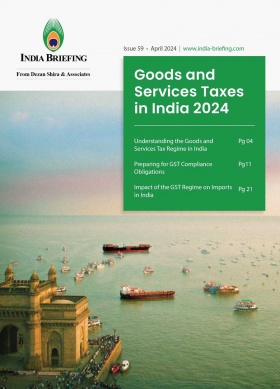Revenue Generated by India’s Top States to be Robust in FY25
Several states in India that contribute heavily to the national GDP are expected to achieve healthy revenue collection in the financial year 2024-25. According to a recent market report, this growth will primarily be driven by robust GST collections and the devolution of finances from the central government, which together comprise around 50 percent of the aggregate state revenue.
The revenue of India’s top 18 states, which contribute over 90 percent to the country’s gross state domestic product (GDP), is expected to grow steadily by 8-10 percent this fiscal year, compared to 7.5 percent in the previous fiscal year. The cumulative revenue of these states is expected to reach approximately INR 38 trillion (US$455 billion).
According to a CRISIL report, this growth is likely to be driven by promising goods and services tax (GST) collections and central government devolution, which together constitute about 50 percent of the states’ total revenues. The 18 states accounted for in this analysis are Maharashtra, Gujarat, Karnataka, Tamil Nadu, Uttar Pradesh, Telangana, Rajasthan, West Bengal, Madhya Pradesh, Andhra Pradesh, Kerala, Odisha, Punjab, Bihar, Chhattisgarh, Haryana, Jharkhand, and Goa.
States record robust GST collection
Experts believe that the primary driver of revenue growth will continue to be state GST collections. These grew by approximately 18 percent last fiscal year and are expected to increase by another 13-14 percent this fiscal year, supported by the resilience of the Indian economy, better tax compliance, and a shift from the unorganized to the organized sectors.
|
State-wise GST Revenue Collection for the Month of May (Value in INR Billion) |
|||
|
State/Union Territory |
May 2023 |
May 2024 |
Growth (%) |
|
Jammu and Kashmir |
4.22 |
5.25 |
24% |
|
Himachal Pradesh |
8.28 |
8.38 |
1% |
|
Punjab |
17.44 |
21.90 |
26% |
|
Chandigarh |
2.59 |
2.37 |
-9% |
|
Uttarakhand |
14.31 |
18.37 |
28% |
|
Haryana |
72.50 |
92.89 |
28% |
|
Delhi |
51.47 |
75.12 |
46% |
|
Rajasthan |
39.24 |
44.14 |
13% |
|
Uttar Pradesh |
74.68 |
90.91 |
22% |
|
Bihar |
13.66 |
15.21 |
11% |
|
Sikkim |
3.34 |
3.12 |
-7% |
|
Arunachal Pradesh |
1.20 |
0.98 |
-18% |
|
Nagaland |
0.52 |
0.45 |
-14% |
|
Manipur |
0.39 |
0.58 |
48% |
|
Mizoram |
0.38 |
0.39 |
3% |
|
Tripura |
0.75 |
0.73 |
-3% |
|
Meghalaya |
2.14 |
1.72 |
-20% |
|
Assam |
12.17 |
12.28 |
1% |
|
West Bengal |
51.62 |
53.77 |
4% |
|
Jharkhand |
25.84 |
27 |
4% |
|
Odisha |
43.98 |
50.27 |
14% |
|
Chhattisgarh |
25.25 |
28.53 |
13% |
|
Madhya Pradesh |
33.81 |
34.02 |
1% |
|
Gujarat |
98 |
113.25 |
16% |
|
Dadra and Nagar Haveli and Daman & Diu |
3.24 |
3.75 |
16% |
|
Maharashtra |
235.36 |
268.54 |
14% |
|
Karnataka |
103.17 |
118.89 |
15% |
|
Goa |
5.23 |
5.19 |
-1% |
|
Lakshadweep |
0.02 |
0.01 |
-39% |
|
Kerala |
22.97 |
25.94 |
13% |
|
Tamil Nadu |
89.53 |
97.68 |
9% |
|
Puducherry |
2.02 |
2.39 |
18% |
|
Andaman and Nicobar Islands |
0.31 |
0.37 |
18% |
|
Telangana |
45.07 |
49.86 |
11% |
|
Andhra Pradesh |
33.73 |
38.90 |
15% |
|
Ladakh |
0.26 |
0.15 |
-41% |
|
Other Territory |
20.1 |
20.7 |
3% |
|
Center Jurisdiction |
1.87 |
2.45 |
30% |
|
Grand total |
1142.61 |
1317.83 |
15% |
Source: Ministry of Finance
In India, a state’s revenue receipts consist of tax revenue, non-tax revenue, state’s share of Union taxes, and duties and grants-in-aid from the central government.
It is estimated that the revenue collection from liquor sales tax, which accounts for 10 percent of state total revenue collection, will remain stable. Sales tax collections from petroleum products, which account for 7-8 percent of total revenue, and grants recommended by the Fifteenth Finance Commission, which constitute 10-11 percent, will see modest mid-single-digit growth.
The CRISIL report notes that 18 leading states, except for Karnataka and Kerala, have kept their liquor tax structures unchanged. It is estimated that the tax revenue from liquor sales is likely to grow by 5-7 percent in FY25. Experts note that revenue from sales tax on petroleum products is expected to grow modestly by 3-4 percent this fiscal year. This growth will be driven by higher fuel consumption due to vehicular and industrial activity, even though the tax structure remains largely unchanged. Despite an anticipated 5-6 percent growth in consumption, recent cuts in petrol and diesel prices will impact sales tax collections by about 200 basis points.
Increase in central tax devolution and grants
Central tax devolution, anticipated to grow by about 12-13 percent this fiscal year, will be the second key driver.
Central tax devolution is the distribution of the net proceeds of Union taxes and duties by the central government to the state governments. It takes place on the 10th of every month and helps states carry out spending on development, welfare, and priority-sector projects and schemes.
While the Finance Commission determines the proportion of devolution, the overall amount is linked to the central government’s gross tax collections, which expanded by around 19 percent last fiscal year and are expected to grow healthily this fiscal year due to rising income tax and GST collections.
|
State-wise Distribution of Net Proceeds of Union Taxes and Duties for June (Value in INR Billion) |
|||
|
No. |
State |
Tax devolved in June 2024 |
Tax devolved in June 2023 |
|
1 |
Andhra Pradesh |
56.55 |
47.87 |
|
2 |
Arunachal Pradesh |
24.55 |
20.78 |
|
3 |
Assam |
43.71 |
37.00 |
|
4 |
Bihar |
140.56 |
118.97 |
|
5 |
Chhattisgarh |
47.61 |
40.30 |
|
6 |
Goa |
5.39 |
4.57 |
|
7 |
Gujarat |
48.60 |
41.14 |
|
8 |
Haryana |
15.27 |
12.93 |
|
9 |
Himachal |
11.59 |
9.82 |
|
10 |
Jharkhand |
46.21 |
39.12 |
|
11 |
Karnataka |
50.96 |
43.12 |
|
12 |
Kerala |
26.90 |
22.77 |
|
13 |
Madhya Pradesh |
109.70 |
92.85 |
|
14 |
Maharashtra |
88.28 |
74.72 |
|
15 |
Manipur |
10 |
8.47 |
|
16 |
Meghalaya |
10.71 |
9.07 |
|
17 |
Mizoram |
6.98 |
5.91 |
|
18 |
Nagaland |
7.95 |
6.73 |
|
19 |
Odisha |
63.27 |
53.56 |
|
20 |
Punjab |
25.25 |
21.37 |
|
21 |
Rajasthan |
84.21 |
71.28 |
|
22 |
Sikkim |
5.42 |
4.59 |
|
23 |
Tamil Nadu |
57 |
48.25 |
|
24 |
Telangana |
29.37 |
24.86 |
|
25 |
Tripura |
9.89 |
8.37 |
|
26 |
Uttar Pradesh |
250.69 |
212.18 |
|
27 |
Uttarakhand |
15.62 |
13.22 |
|
28 |
West Bengal |
105.13 |
88.98 |
|
|
Total |
1,397.50 |
1,182.80 |
Source: Ministry of Finance
In line with the upcoming Union Budget allocation, grants from India’s central government are also expected to grow by 4-5 percent annually. This includes centrally sponsored schemes and Finance Commission grants for post-devolution revenue deficits based on budget calculations and the commission’s stipulations.
These projections have been made on the basis of India’s expected real GDP growth of 6.8 percent for this fiscal year (FY25). However, global economic volatility could affect these revenue forecasts. Conversely, better-than-expected tax revenues or additional support from the central government through higher grants could boost state revenues.
(US$1 = INR 83.51)
About Us
India Briefing is one of five regional publications under the Asia Briefing brand. It is supported by Dezan Shira & Associates, a pan-Asia, multi-disciplinary professional services firm that assists foreign investors throughout Asia, including through offices in Delhi, Mumbai, and Bengaluru in India. Readers may write to india@dezshira.com for support on doing business in India. For a complimentary subscription to India Briefing’s content products, please click here.
Dezan Shira & Associates also maintains offices or has alliance partners assisting foreign investors in China, Hong Kong SAR, Dubai (UAE), Indonesia, Singapore, Vietnam, Philippines, Malaysia, Thailand, Bangladesh, Italy, Germany, the United States, and Australia.
- Previous Article India to Fund AI Computing Infrastructure with 10,000 GPUs
- Next Article India impulsará a Asia del Sur como la región de más rápido crecimiento: Banco Mundial








